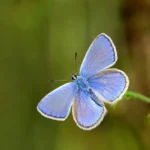Butterflies That Are Easy to Find and Identify
During one of our butterfly walks we will probably spot about ten species of butterfly, which would be typical of what might be seen on a summer’s morning with the family in mid June. This may be perhaps slightly disappointing since 22 of the 60 odd butterfly species to be found in Britain have been reported along the line, However a number of butterflies have become more scarce in recent years, and the Wall butterfly, previously seen on the Nickey Line, has not been reported for many years.
In the grassy areas meadow browns are easy to find. When this medium sized butterfly is in flight it looks a light brown colour and when resting it clearly displays an orange-brown stripe on the underside of its forewings.




Another much smaller butterfly is the large skipper which has a very characteristic way of folding its wings when resting.
Ringlets which are small butterflies appear very dark in flight but if they can be seen sitting still with their wings folded they display the beautiful rings that give them their name.
The Speckled Wood and Marbled White
Under the trees it is usually possible to spot the speckled wood, which is medium sized and brownish, but almost the only butterfly to fly in the shade of the trees over the line. If the wings are outspread when the butterfly rests, the speckled nature of the patterning is obvious.
The marbled white has colonised across the Nickey Line and can be found in the meadows either side and on the steep roadside banks leading down to the roundabout on the Redbourn bypass. It is obviously different from the other whites by the black checkerboard-like markings on its wings, which can even be seen in flight.



Common Blue
Another butterfly that can often be found is the common blue. At this time of the year the holly blues are not flying, so any blue you see is likely to be the common blue. The trouble is the male may be blue, but the female tends have more brown on the wings and is therefore less conspicuous.
The Mystery of Bee Orchids
 Bee orchids are fickle, they appear one year and are gone the next, but usually they are to be found towards the end of June and into July somewhere along the line.
Bee orchids are fickle, they appear one year and are gone the next, but usually they are to be found towards the end of June and into July somewhere along the line.
They, like most other orchids, produce two masses of pollen called pollinia. The mechanism of orchid pollination is normally that pollinia are attached to the heads of pollinators and the whole package is then deposited on the female parts when the insect visits another flower. In related species of Ophrys, like the fly orchid, the pollinator is a male insect that hatches out before its females, and mistaking the orchid flower for a female, attempts to mate with it. In the process, the orchid sticks pollinia on the head of the insect. We know what this insect is for the fly orchid, but none has ever been found for the bee orchid; if it exists it is a mystery. It has presumably died out. The bee orchid has evolved a solution, the pollinia are not released, they simply tip over and curl round to touch the female parts, so the bee orchid perpetually self-pollinates.
Nature Notes
- Wildlife Along the Nickey Line
- January Nature Notes
- February Nature Notes
- March Nature Notes
- April Nature Notes
- May Nature Notes
- June Nature Notes
- July Nature Notes
- August Nature Notes
- September Nature Notes
- October Nature Notes
- November Nature Notes
- December Nature Notes
- Wildlife Interpretation Board
- Nickey Line Fungal List
